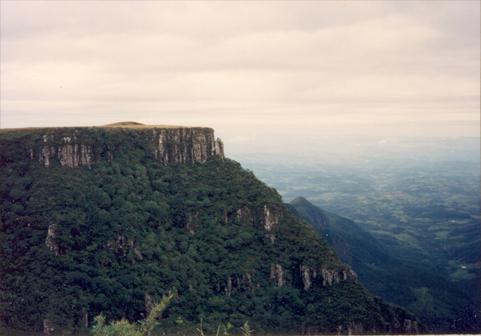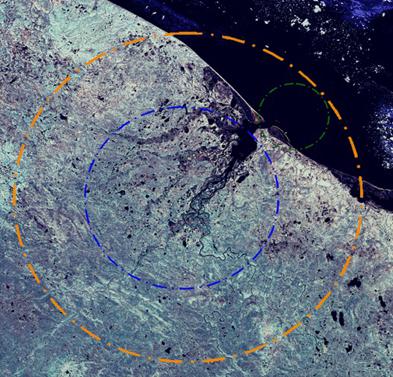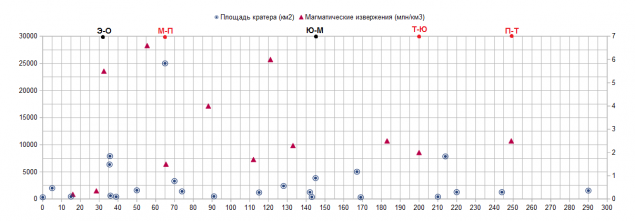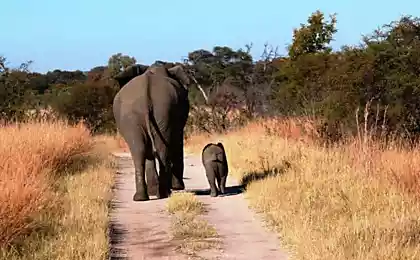2485
What killed the "terrible lizards"? On the generators of mass extinctions

In the history of life on earth, there are scientists to 11ti mass extinctions of flora and fauna, 5 of which greatly changed the face of our biosphere. The last of these "big" extinction occurred 65 million years ago, destroyed 1/6 of all the then existing species (Cretaceous-Paleogene extinction). At the same time, together with the sea and the flying lizards, most disappeared "propiarenny" detachment animals in the fossil record of our world - all dinosaurs.
Modern science does not have comprehensive data on the causes of the last major extinction of species (as indeed, the previous). Among the prime suspects - asteroids, volcanoes and internal processes in the Earth's biosphere. Below, I suggest that you read the chronicle of terrestrial catastrophes long in 300 million years, and make your own opinion about the causes of the death of this great squad reptiles.
"The mother of all extinctions»
250 million years ago was the largest known extinction in the history of our planet during the Permian-Triassic catastrophe killed 95% of all species of marine and land animals. Disappeared almost all the then dominant land therapsids. Among the few survivors were therapsids Cynodont ancestors, descendants of whom are all mammals.
By the bestial Lizards (Synapsid) include Pelycosaur Early Permian (left Dimetrodon) and their descendants therapsids (right Gorgonops). In particular Gorgonopsia are close relatives Cynodont i>

Vacated ecological niches occupied therapsids archosaurs that after 20 million years will dominate both land predators (dinosaurs and Crurotarsi).
The main cause of this extinction is generally considered the outpouring of igneous Siberian Traps on the boundary of the Permian and Triassic periods. During the formation of the trap was thrown about 4 million km3 of rock, covered an area of 2 million km2. Process outpouring of rocks launched cascade of global climate change as a result, presumably, and cause mass extinction.
The area of the eruption of the Siberian Traps superimposed on the map of modern Russia i>

"Mysterious" Triassic-Jurassic extinction
Already after 50 million years, the Earth's biosphere has had to face a new series of mass extinctions. At the boundary of the Triassic and Jurassic periods unknown global cataclysm caught ruling on land Crurotarsi. Surpassing their "cousins" of dinosaurs and mammals, Crurotarsi that time were the main and largest land predators Late Triassic.
Some representatives of prey Crurotarsi Late Triassic i>

As a result of the disaster Crurotarsi shared the fate of therapsids, giving way to his "cousins" - dinosaurs, which will dominate the land 140 million years long. One of the two surviving groups Crurotarsi - Protosuchia are direct ancestors of modern crocodiles.
As the main versions of the extinction considered fall of a large asteroid and volcanic activity (the Central Atlantic magmatic province, tsampa). In the first case, the cause of this strike 4 km asteroid is formed by 100 km crater Manicouagan in Canada, but the geological dating assigns it to fall to 14 million years to the Triassic extinction.
Today Manicouagan crater has a transverse diameter of 70 km (originally - 100km). Craters of this size typically occur in the fall of asteroids with a diameter of about 4-5 km, and do not have long-term consequences for the earth's flora and fauna i>

The greatest support for the combined hypothesis. According to her tsampa, which caused an outpouring of 2 million km3 of volcanic rock, including a huge amount of CO2, provoked by global warming release of huge ocean bottom "pockets" of methane hydrates. Methane, being more potent greenhouse gas than CO2, start a chain reaction of overheating the Earth's atmosphere, which, presumably, and caused mass extinctions.
"Stable" Mesozoic
During the rule of the dinosaurs on land (Jurassic and Cretaceous periods of the Mesozoic era) was not a geologically "calmer" rest periods of Earth's history.
183 million years ago there was an outpouring of the Karoo large igneous-Ferrari, comparable in magnitude with tsampa (2, 5 million km3 of igneous rocks). However, this event does not result in cracks or whether catastrophic consequences for life on earth. Passed without serious consequences, and the collision with the Earth of a large asteroid with a diameter of about 4 km 167 million years ago - in the middle of the Jurassic period (destroyed Пучеж-Катунский Crater in the Nizhny Novgorod region of Russia).
The second mass extinction in the history of dinosaurs occurred on the border of the Jurassic and Cretaceous periods - 145 million years ago. One of the many hypotheses connects with this "small Jurassic" extinction of the formation of one of the largest shield volcanoes of the solar system - the array Tamu in the Pacific Ocean. However it is possible that the global effect of the formation of the impact force of a volcano 4 km asteroid in the same time interval (кратер Morokweng crater , South Africa). By this time, scientists have attributed the appearance of flying dinosaurs - the ancestors of modern birds.
Tamu Massif in the Pacific Ocean is one of the largest extinct volcanoes of the solar system. The total mass of composing this ancient volcano rocks is 80% of the Martian Mount Olympus i>

Approximately 12 million years later, at the beginning of the Cretaceous period, the world of flora and fauna has survived a series of the largest explosive volcanic eruptions in the earth's history. Eruption in the early Cretaceous Hauterivian 8 supervolcano freed in the amount of 50 000 km3 of gases and rocks. So supervolcano eruption on each power on average doubled the force of the eruption of the Toba supervolcano, 70,000 years ago, was the cause of эффекта "Bottleneck» .
The fact is notable for the fact that "hits" supervolcano was only part of the process of formation of giant magma trap para-Etendeka South Amerike. The total volume of the released species was 2, 3 million km3. However, as 50 million years earlier, these processes do not cause significant fluctuations in the diversity of the Earth's biosphere.
ledges formed by basaltic magma flows ancient trap of Parana, Brazil i>

By the end of his era, dinosaurs survived another three major peaks of volcanic activity in the amount of 12 million km3 izvergshie rocks. During the Cretaceous Earth just gone through a series of collisions with large asteroids (3 asteroid with a diameter of 1 km, three 2 km, and a size 3 km).
The largest (after the Chicxulub) impact crater Cretaceous - Kars located in the Nenets Autonomous Okrug of Russia. Beat 3 km of the asteroid 70 million years nazat formed a crater about 70 km. In addition, the reduction period is the beginning of speciation dinosaurs, although the link between these two events is the subject of discus i>

End of Eternity
If we could get to the end of the Cretaceous period, many of us would not have believed that they were in ancient and alien world. Everywhere dominated angiosperms (flowering), underfoot were busy mammals, differs little from modern than large animals. They have already split into placental and marsupial. At the same time lived and the first primates. There were snakes and lizards are familiar to us. Since the Jurassic forests infested by these birds, crocodiles and their relatives ambushed animals come to the river.
Bees just feel kind of liability for the reduction of diversity of dinosaurs in the Late chalk. Evolved about 100 million years ago from the supply of pollinating insects wasps, bees due to its high efficiency did flowering plants dominate in the Earth's flora. Herbivorous dinosaurs, not without difficulties had to slowly change the diet with gymnosperms to flowering plants i>

Similarities of our world with the ancient limited to the fauna in mental watering, most of which were still dinosaurs: tiranozavridy, ceratopsians, hadrosaurs, sauropods, etc (more than detailed list of fauna end of the era of the dinosaurs).
By the end of the era of dominance of dinosaurs on the boundary of the Cretaceous and Paleogene periods of increased volcanic activity in India (then an island in the Indian Ocean). The volume of the outpouring of Deccan Traps for several hundred thousand years amounted to about 2 million km3, peaked in the eruption of lava Rajahmundry Traps Mahabaleshwar, when for a short (geologically) period emissions amounted to 9 thousand. Km3 of rock.
Deccan Traps near Mumbai and a map of the area occupied by India (blue) i>

However, previous precedents colossal volcanic activity, we already know that such phenomena themselves are not necessarily catastrophic impact on the earth's climate, and consequently flora and fauna. Most likely, this activity must be matched with exceptional circumstances, to run the "mechanism" of mass extinction.
Only 6 of the 11 major extinctions coincided in time with the active geological processes. Most modern paleontologists of the opinion that such "exceptional circumstances" was a hit 10 km asteroid in Central America 65 million years ago, during the active phase of education Deccan Traps.
Power strike was unprecedented in the history of the Mesozoic era. The energy release 2 million times the energy of the explosion of the largest thermonuclear charge - "King of the bombs." The area formed the Chicxulub crater 180 km was comparable to the total area of impact craters formed in the past 200 million years.
According to some geological models, seismic waves from the explosion could focus at the antipode of impact crater and lava eruptions cause (or reinforce them). By the way, at the antipode-collision region was then increased volcanic activity - the very Deccan Traps. The hypothesis does not claim that volcanism was triggered by an asteroid impact, since the formation of the trap data was purely autonomous process of the Earth's lithosphere. It is only about a possible short-time increase in volcanic activity, as the phenomenon of "seismic focus" in the particular case of the Earth strong constraints < / a>.
Chicxulub crater on the Yucatan Peninsula (Mexico). Left - a crater in the visible range, right - overlay maps of gravity anomalies i>

Another important condition for the beginning of the process of mass extinction is the state of flora and fauna at the time of "force majeure". As before the Permian-Triassic extinction, paleontologists fix a reduction in the diversity of dinosaurs and the other archosaurs in Maastricht tier pozdengo Cretaceous (the last 7 million years of existence dinozarov). Attribute this to global climate change as well as the reduction of diversity extended to many other groups of plants and animals (including mammals, birds and flowering). This gave rise to many paleontologists suggest that these two catastrophic events (volcanoes and asteroid) occurred in an "uncomfortable" for living fauna time.
Schedule frequency (right scale) and (left scale) over the last 300 million years (of confirmation). The former have a relatively long-term effect on the climate (millions of years), the impact of asteroids "experienced" nature within a few tens of thousands of years. As can be seen natural disasters do not always provoke mass extinctions (red dots at the top - the large extinction, black - small) i>

Schedule "short-time" for poslenie volcanic eruptions 140 million years. Unlike the explosive lava eruptions are not accompanied by significant explosive discharge of molten rock. The process of eruption is relatively easy. Red circle denotes the eruption of the Toba supervolcano, 70 thousand years ago, i>

"Great Break»
The last of the great extinctions and fourth in mammals occurred at the border of the Eocene and Oligocene epoch Paleogene period 35-30 million years ago. Percentage of species extinction is several times higher than the "background" level - more than 3% versus 0, 7% (in order of magnitude weaker Cretaceous extinction). This is the longest of all extinctions last 300 million years lasted 4 million years. Connect the Eocene-Oligocene extinction event as the fall of two large asteroids 35 million years ago (~ 5 and ~ 4 km in diameter, respectively), and with a significant global volcanic activity 35-29 million years ago (North, Central and South America, Africa and Middle East, see fig. above).
100 and 90 km craters Popigaj (Russia) and Chesapeake (USA), formed with a small time interval of 35 million years ago, and is expected to become one of the causes of Eocene-Oligocene extinction event and the general cooling of climate in the Oligocene i>

"Leviathan»
However, according to many modern biologists, Eocene-Oligocene extinction event was not the last. Since the last ice age, 11,000 years ago, Earth's biosphere beginning to experience another "great extinction" in its history () . It has already exceeded the scale Eocene extinction, and scientists estimate species diversity of fauna of our planet decline by 50% by the end of this century (more than 80% of the earth's flora). And the cause is not volcanoes or asteroids, and the emergence and development is not very usual species - Homo sapiens.
As you can see in the illustration below, the appearance of a man often provokes a sharp decrease in the number of large mammals (megafauna). In Africa and South Asia, the effect was weaker as the fauna i> with a gradually successive kinds of people. On other continents, where the appearance of "super hunter" was a relatively sharp reduction effect was much more substantial i>

Unfortunately, we often forget that the intellectual superiority of man over the rest of the wildlife and must be accompanied by a big responsibility, not predatory and often irrational plunder and destruction of its benefits. Let's hope that it still does not reach & quot;
Engineer saved the life of a device which he himself developed and
What is the working day on the ISS























